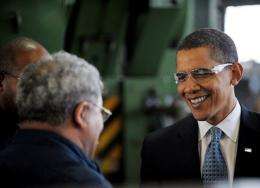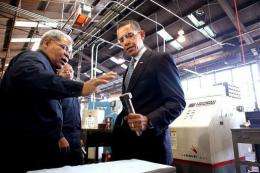Hopes for Obama's wave of green jobs fades to gray

President Barack Obama has put the government's weight and dollars behind a push for green jobs, but in the US heartland there are doubts his drive can revive manufacturing's glory days.
Economic malaise is nothing new to northern Ohio, the recession-blighted region that was once a showcase for American manufacturing splendor.
Pummeled by decades of industrial decline and jobs being shipped overseas, the region's biggest city, Cleveland, has seen its population of nearly a million in 1950 more than halve.
Cruelly dubbed the "mistake by the lake," the now half-empty city received another hammer blow during the recent downturn, which shuttered even more factories and sent unemployment soaring.
"We have seen pretty big declines in manufacturing-sector employment," said Guhan Venkatu, an economist at the Federal Reserve Bank of Cleveland, in describing a lost decade for the state.
"Some of the jobs will come back as we get deeper into the recovery, but most of them won't."
Yet throughout the latest crisis there has been one beam of hope: That the global race to develop green technology could help resuscitate the region.
With Obama investing billions to help stimulate the green economy, local authorities in Ohio have wagered that a skills base honed over decades could be tapped in that quest.
Lisa Patt-McDaniel, director of the Ohio Department of Development, spends her days trying to help the young shoots of Ohio's green economy break through its ash-laden soil.
The effort is about "investing in future technology that will build on the manufacturing strengths that we already have in the state," she said.
As a result, glass factories that once pumped out products for the auto industry are now focused on making solar panels, while shop floors that produced gears now crank out parts for wind turbines.
According to Patt-McDaniel, one green-tinged technology drive called the "third frontier" has created 9,000 jobs directly and about 45,000 secondary jobs in the eight years it has been in existence.
Still, despite this success, Obama's hopes of ushering in a tidal wave of green-collar jobs to rescue the languishing manufacturing sector are facing strong crosscurrents.

The Cleveland Fed's Venkatu argues the destruction of manufacturing jobs was caused by a range of factors, many of which apply equally to green manufacturing.
"It is not simply about the geographic pattern of production, of production moving offshore," said Venkatu.
"It would be very difficult to regain what has been lost in part because these are being driven by economic factors, increasing globalization and improvements in technology."
Between 2000 and 2005 technology advances meant output per manufacturing worker increased around 30 percent, he said.
That increased productivity means companies can employ fewer workers to do the same of work.
It is a trend also seen by John Colm, the head of WIRE-Net -- a nonprofit group that helps manufacturing firms in Cleveland.
"Regions would formerly hope to get a big auto plant because it would put a lot of people to work with only a high school education -- that equation just does not work anymore," he said.
Because Ohio has lost 400,000 jobs in the last four years and continues to lose jobs at a rate of around 17,000 per month, even Patt-McDaniel is careful not to overstate the impact green jobs, or the government, can have.
"I don't think that the third frontier is going to replace all the jobs that are no longer manufacturing jobs in the state," she said.
But that does not mean it is not worth trying.
"You are always creating jobs, and jobs are being let go. The game is trying to create more jobs than are being abolished. That is what we are aiming for."
Colm agreed: "If we still have the firms and they are organized and they are bringing wealth into a region, then that is healthy, that is good. It might be a smaller, leaner company in terms of employment, but that is the new reality."
(c) 2010 AFP
















